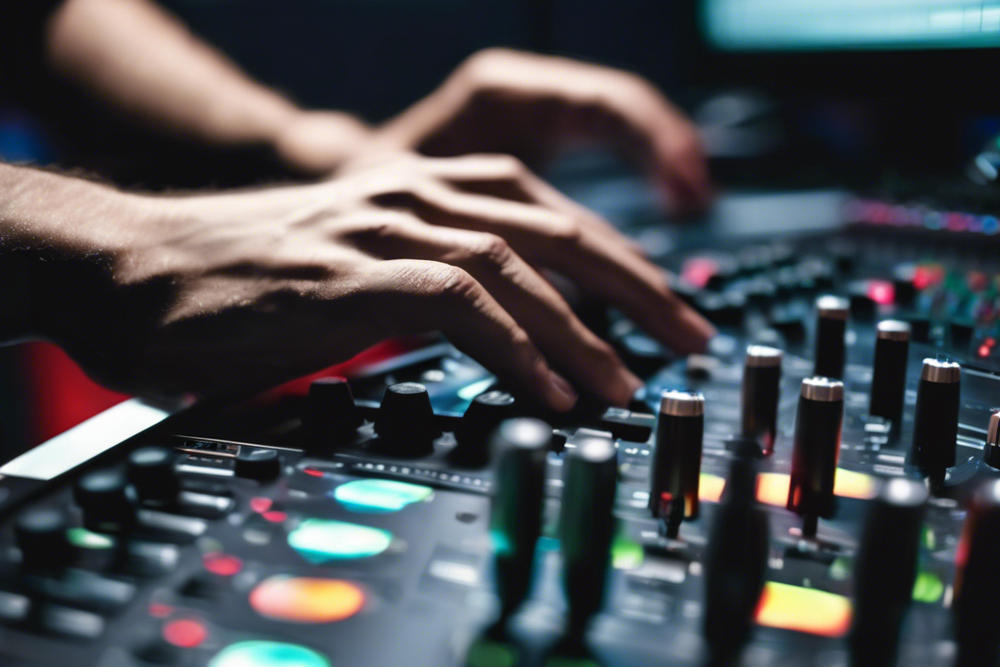Estimated reading time: 9 minutes
Sidechaining is a powerful audio processing technique that has become an essential tool in the world of music production. It allows you to dynamically control the volume of one audio signal based on the level of another. This technique is particularly useful for creating that signature “pumping” effect that you hear in many electronic and dance music tracks. In this comprehensive guide, I’ll walk you through the step-by-step process of setting up sidechain compression in FL Studio and explore various techniques to help you achieve the perfect pump.
Table of contents
- Understanding the Basics of Sidechain Compression
- The Importance of Sidechain Compression in Achieving the Perfect Pump
- Step-by-Step Guide to Setting Up Sidechain Compression in FL Studio
- Exploring Sidechain Settings and Parameters
- Using a Kick Drum as a Sidechain Source
- Sidechaining Techniques for Bass Tracks
- Achieving Dynamic Control with Sidechain Compression
- Advanced Sidechaining Techniques and Creative Applications
- Sidechain Alternatives and Alternatives to Sidechain Compression
- Troubleshooting Common Sidechain Issues
- Conclusion and Final Thoughts on Mastering the Sidechaining Technique
- FAQ
Understanding the Basics of Sidechain Compression
At its core, sidechain compression is a type of dynamic range compression that uses one audio signal (the “sidechain” signal) to control the volume of another audio signal (the “main” signal). The sidechain signal is typically a percussive element, such as a kick drum, which is used to trigger the compression on the main signal, like a bass track or synth. This creates a rhythmic pumping or ducking effect, as the main signal is reduced in volume every time the sidechain signal (the kick drum) is triggered.
| Concept | Description |
|---|---|
| Sidechain Signal | The audio signal used to trigger compression on another track, typically a percussive element like a kick drum. |
| Main Signal | The audio track that gets compressed, such as a bass track or synth. |
| Triggering Effect | Compression occurs on the main signal when the sidechain signal is present, creating a pumping or ducking effect. |
| Compression Goal | Achieve dynamic interplay and rhythmic coherence between different elements of the mix. |
| Common Application | Used extensively in electronic and dance music to add energy and movement to the track. |
| Resulting Effect | A rhythmic reduction in volume of the main signal, synced with the sidechain signal. |
The Importance of Sidechain Compression in Achieving the Perfect Pump
Sidechain compression is essential for creating that signature “pumping” effect that is so prevalent in electronic music. By using the kick drum to trigger the compression on the bass or synth, you can achieve a tight, rhythmic interplay between the low-end elements and the percussive elements of your track. This not only adds energy and movement to your mix but also helps to create a more cohesive and polished sound.
| Aspect | Description |
|---|---|
| Signature Effect | Creates the characteristic “pumping” effect in electronic and dance music. |
| Rhythmic Interplay | Enhances the rhythmic interaction between low-end and percussive elements. |
| Energy and Movement | Adds dynamic energy and movement to the mix, making it more engaging. |
| Cohesion | Ensures a cohesive sound by preventing bass and kick drum clashes. |
| Mix Clarity | Helps in maintaining clarity by giving space to each element in the mix. |
| Polished Sound | Contributes to a more professional and polished overall production. |
Step-by-Step Guide to Setting Up Sidechain Compression in FL Studio
- Insert a Compressor Plugin: In FL Studio, you can use the built-in Fruity Limiter or any other compressor plugin of your choice. Place the compressor on the audio track you want to sidechain, such as a bass or synth.
- Access the Sidechain Settings: In the compressor plugin, look for the “Sidechain” or “Side-Chain” section. This is where you’ll be able to configure the sidechain settings.
- Select the Sidechain Source: In the sidechain settings, you’ll need to choose the audio track that will be used as the sidechain source. This is typically the kick drum track.
- Adjust the Sidechain Threshold: The threshold setting determines the level at which the sidechain signal will trigger the compression. Start with a relatively low threshold and adjust it until you achieve the desired pumping effect.
- Experiment with the Attack and Release Times: The attack and release times of the compressor will determine how quickly the compression is applied and released. Experiment with different settings to find the perfect balance for your track.
- Fine-Tune the Ratio and Gain Reduction: Adjust the ratio and gain reduction settings to control the amount of compression applied to the main signal. A higher ratio will result in a more pronounced pumping effect.
- Monitor the Sidechain Visualization: Many compressor plugins will provide a visual representation of the sidechain signal and the resulting compression. Use this to fine-tune your settings and ensure the pumping effect is in sync with the kick drum.
Exploring Sidechain Settings and Parameters
The sidechain settings and parameters in your compressor plugin will have a significant impact on the overall pumping effect. Experiment with the following settings to achieve your desired sound:
- Threshold: Determines the level at which the sidechain signal will trigger the compression.
- Attack: Controls how quickly the compression is applied when the sidechain signal exceeds the threshold.
- Release: Determines how quickly the compression is released after the sidechain signal drops below the threshold.
- Ratio: Adjusts the amount of compression applied to the main signal.
- Gain Reduction: Displays the amount of gain reduction being applied to the main signal.
Using a Kick Drum as a Sidechain Source
The kick drum is the most common sidechain source, as it provides a clear, rhythmic trigger for the compression. By sidechaining your bass or synth tracks to the kick drum, you can create a tight, pumping effect that adds energy and movement to your mix.
When setting up the sidechain, make sure to select the kick drum track as the sidechain source in your compressor plugin. Experiment with the threshold, attack, and release settings to find the perfect balance between the kick drum and the main signal.
Sidechaining Techniques for Bass Tracks
Sidechaining is particularly effective for bass tracks, as it helps to create a cohesive and dynamic low-end in your mix. By sidechaining the bass to the kick drum, you can ensure that the bass doesn’t overwhelm the kick and that the two elements work together seamlessly.
Start by inserting a compressor on the bass track and selecting the kick drum as the sidechain source. Adjust the threshold, attack, and release settings until you achieve the desired pumping effect. You can also experiment with the ratio and gain reduction to fine-tune the compression.

Achieving Dynamic Control with Sidechain Compression
One of the key benefits of sidechain compression is its ability to provide dynamic control over your audio signals. By using the sidechain signal to trigger the compression, you can create a sense of movement and energy in your mix that would be difficult to achieve through traditional volume automation.
For example, you can use sidechain compression to create a pulsing effect on a synth or pad track, or to ensure that the bass doesn’t overpower the kick drum during the chorus of a song. The possibilities are endless, and the more you experiment with sidechain compression, the more you’ll discover its creative potential.
Advanced Sidechaining Techniques and Creative Applications
While the basic sidechain setup we’ve covered so far is a great starting point, there are many advanced techniques and creative applications you can explore to take your sidechaining to the next level. Here are a few ideas to get you started:
- Sidechain Reverb: Use sidechain compression to control the volume of a reverb effect, creating a “breathing” or “pumping” reverb sound.
- Parallel Sidechaining: Set up a parallel sidechain signal, allowing you to blend the compressed and uncompressed versions of the main signal for more control.
- Multiband Sidechaining: Use a multiband compressor to sidechain different frequency ranges of the main signal, allowing for more targeted and nuanced control.
- Sidechaining with Other Plugins and Effects: Experiment with sidechaining your audio signals to other plugins and effects, such as gates, filters, and even distortion units.
Sidechain Alternatives and Alternatives to Sidechain Compression
While sidechain compression is a powerful and widely-used technique, it’s not the only way to achieve dynamic control in your mixes. Here are a few alternatives to consider:
- Volume Automation: Manually automating the volume of your audio tracks can provide a similar pumping effect, but may require more fine-tuning and attention to timing.
- Peak Controllers: Some DAWs and plugins offer peak controllers, which allow you to trigger volume changes based on the peak levels of an audio signal, rather than a sidechain.
- Sidechaining with MIDI: Instead of using an audio signal as the sidechain source, you can use a MIDI signal, such as a kick drum or percussion pattern, to trigger the compression.

Troubleshooting Common Sidechain Issues
As with any audio processing technique, you may encounter some common issues when working with sidechain compression. Here are a few troubleshooting tips:
- Timing Issues: Make sure the sidechain signal is properly aligned with the main signal to ensure the pumping effect is in sync.
- Overcompression: If the pumping effect is too pronounced, try adjusting the threshold, ratio, or gain reduction settings to find the right balance.
- Unwanted Artifacts: Check for any unwanted noise or distortion introduced by the sidechain compression, and adjust the settings accordingly.
Ready to take your music production to the next level with sidechain compression? Download our sample packs with sidechained audio-files.
Conclusion and Final Thoughts on Mastering the Sidechaining Technique
Sidechain compression is a powerful tool that can transform your music production and help you achieve that signature “pumping” effect. By understanding the basics of how it works and experimenting with the various settings and techniques, you can unlock a whole new world of creative possibilities.
Remember, the key to mastering sidechain compression is to keep an open mind, be patient, and don’t be afraid to experiment. With practice and persistence, you’ll be able to create dynamic, engaging mixes that will captivate your listeners.
Related Posts
- How to Compress Vocals? A Step-by-Step Guide to Perfectly Compressed Vocals
- How to use an Audio Interface? A Beginner’s Guide
- How to Make Loops: A Guide for Music Producers
- How to Clear a Sample? A Step-by-Step Guide for Musicians and Producers
- How to Make Your Beats Louder: Tips for Maximum Volume and Quality
- How to Fix Peaking Audio: Essential Tips for Clear Sound
FAQ
Sidechain compression is used to dynamically control the volume of one audio signal (the “main” signal) based on the level of another audio signal (the “sidechain” signal). This is commonly used to create a pumping or ducking effect in electronic and dance music.
In FL Studio, you can use the built-in Fruity Limiter or any other compressor plugin. Insert the compressor on the audio track you want to sidechain, then select the sidechain source (typically the kick drum) in the sidechain settings.
The optimal sidechain settings will depend on your specific track and desired effect. Experiment with the threshold, attack, release, ratio, and gain reduction to find the perfect balance.
Absolutely! Sidechain compression can be applied to a wide range of audio tracks, including vocals, pads, and even drums, to create dynamic and interesting effects.
Yes, there are a few alternatives to sidechain compression, such as volume automation, peak controllers, and sidechaining with MIDI. These techniques can provide similar dynamic control, but may require more manual adjustments.



